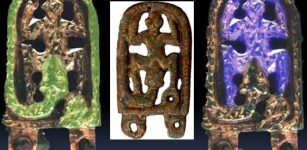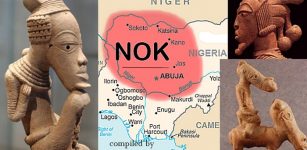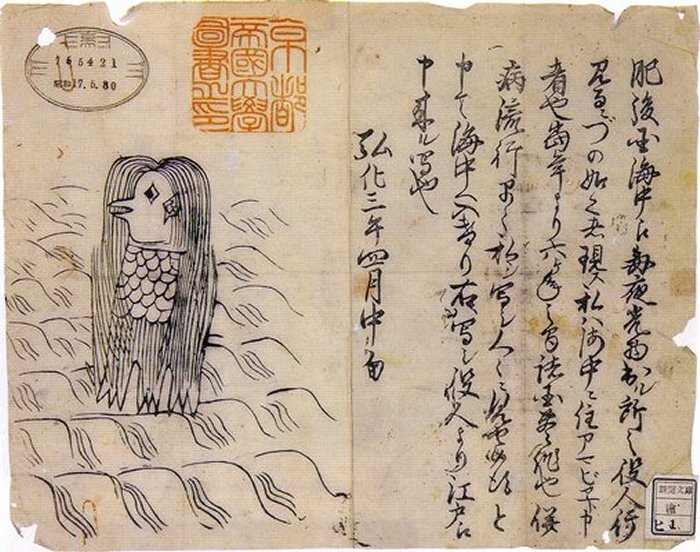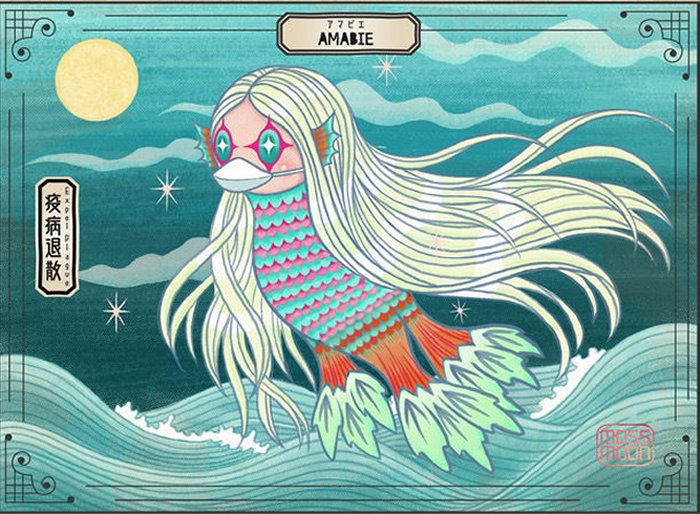Yokai Amabie – Protective Ancient Spirit That Can Ward Off Epidemics
Ellen Lloyd - AncientPages.com - Those who are not familiar with Japanese folklore have probably never heard about Amabie, but this little creature reminds us of the difficulties we must endure because of the coronavirus outbreak.
In Japanese mythology we encounter various types of Yokai, and one of them is known as Amabie. A Yokai is basically supernatural beings that dwell in the borderlands and in spaces, which are located “in-between”.
An amabie. Wood-block print, late Edo period. Credit: Public Domain
“Yokai begin where language ends. Mysterious sounds. Lights flitting through the graveyard. A flood that destroys one village and leaves another unscathed. A feeling that something is watching you in the darkness. How do we speak of things that are ungraspable, anomalous? What words can we use to signify things that evade established categories and seemingly refuse to conform to the laws of nature?
In Japan, as elsewhere, inexplicable occurrences and supernatural creatures have been part of the cultural imagination for as long as history has been recorded.
Broadly speaking, these diverse mysterious phenomena and weird “things” have come to be called yokai. In a sense, yokai is nothing more than a convenient label to indicate a whole range of otherwise ineffable experiences that might, in English, be translated with the words spirits, goblins, phantoms, specters, sprites, shape-shifters, demons, fantastic beings, numinous occurrences, the supernatural, and perhaps most commonly today, monsters.
This wide variety of possible translations speaks to the open-endedness of the word and hints at the many different ideas and nuances associated with it,” Michael Dylan Foster writes in his book The Book of Yokai: Mysterious Creatures of Japanese Folklore.
Amabie is a Japanese mermaid-like creature with long hair, a beak, and 3 legs.
According to an Edo-period tile block print dated 1846, Amabie appeared off the coast of Kumamoto, Japan. Amabie predicted a bountiful harvest for the next six years, but that’s not all.
This mythical Yokai came to humans with a message, giving people advice in case of an epidemic.
Amabie said - “Good harvest will continue for six years from the current year if disease spreads, show a picture of me to those who fall ill and they will be cured.” Afterward, Amabie returned to the sea, but the memory of the enigmatic creature has been kept alive.
via This is Colossal
Currently many are sharing drawings of Amabie on social media in hopes of repelling disease.
Since Yokai are believed to be creatures with supernatural powers, many artists in Japan and other countries are now turning to this protective ancient spirit that is said to ward off epidemics. By drawing images of Amabie, people are showing support against the coronavirus.
In accounts of Amabie, it is sometimes said that the image itself can ward off the epidemic,” Jack Stoneman, a Professor of Asian and Near Eastern Languages at Brigham Young University said.
“This is not unusual in Japanese cultural history—images as talismans.”
When Kaori Hamura Long was at home with flu-like symptoms she drew Amabie wearing a mask. Credit: Kaori Hamura Long
The fact that we can find images of Amabie on social media shouldn’t be interpreted as a religious call for help. As the coronavirus pandemic continues to take its toll, Amabie is here to show us that we are not alone. These wonderful images created by artists all over the world show solidarity. In times like these, it’s more important than ever to stand united.
Drawing an image of Amabie will not help us overcome the coronavirus outbreak, but it may give us some comfort and inner peace.
Written by Ellen Lloyd – AncientPages.com
Copyright © AncientPages.com & Ellen Lloyd All rights reserved. This material may not be published, broadcast, rewritten or redistributed in whole or part without the express written permission of AncientPages.com and Ellen Lloyd
More From Ancient Pages
-
 Cahuachi – Complex Of Truncated Adobe Pyramids In Peru’s Desert
Civilizations | Aug 27, 2015
Cahuachi – Complex Of Truncated Adobe Pyramids In Peru’s Desert
Civilizations | Aug 27, 2015 -
 Birka Artifacts Shed Light On Vikings’ Daily Life
Artifacts | Jun 24, 2019
Birka Artifacts Shed Light On Vikings’ Daily Life
Artifacts | Jun 24, 2019 -
 An Intact 4,000-Year-Old Burial Chamber Found In Aswan
Archaeology | Mar 28, 2017
An Intact 4,000-Year-Old Burial Chamber Found In Aswan
Archaeology | Mar 28, 2017 -
 Galileo Galilei’ Long-Lost Letter Reveals His Attempt To Fool The Inquisition And Make Science Independent From Religion
Archaeology | Sep 22, 2018
Galileo Galilei’ Long-Lost Letter Reveals His Attempt To Fool The Inquisition And Make Science Independent From Religion
Archaeology | Sep 22, 2018 -
 Unique Ancient Makeup Mixture Based On Black Powder Discovered In The Kani Koter Cemetery
Archaeology | Jul 14, 2025
Unique Ancient Makeup Mixture Based On Black Powder Discovered In The Kani Koter Cemetery
Archaeology | Jul 14, 2025 -
 Perperikon, Tomb Of Orpheus And A Small Baffling Stone – Unraveling A Puzzling Connection That May Solve A Mythological Riddle
Ancient Mysteries | Feb 5, 2019
Perperikon, Tomb Of Orpheus And A Small Baffling Stone – Unraveling A Puzzling Connection That May Solve A Mythological Riddle
Ancient Mysteries | Feb 5, 2019 -
 Kahina – The Prophetic Berber Queen Who Resisted The Muslim Invasions Of The Numidia Kingdom
Featured Stories | Aug 14, 2021
Kahina – The Prophetic Berber Queen Who Resisted The Muslim Invasions Of The Numidia Kingdom
Featured Stories | Aug 14, 2021 -
 Caribbean Cannibalism Theory – Debunked By Researchers
Archaeology | Apr 16, 2021
Caribbean Cannibalism Theory – Debunked By Researchers
Archaeology | Apr 16, 2021 -
 Meat And Fish Market Uncovered In Ancient City Of Aigai, Turkey
Archaeology | Nov 3, 2018
Meat And Fish Market Uncovered In Ancient City Of Aigai, Turkey
Archaeology | Nov 3, 2018 -
 Does A Baffling Artifact Offer Evidence Of Ancient Extraterrestrial Visitation In New Zealand? – The Discovery – Part 1
Ancient Mysteries | Jul 20, 2020
Does A Baffling Artifact Offer Evidence Of Ancient Extraterrestrial Visitation In New Zealand? – The Discovery – Part 1
Ancient Mysteries | Jul 20, 2020 -
 Symbol of Immortality: Honey Offering In A 2,500-Year-Old Shrine – Identified
Archaeology | Aug 28, 2025
Symbol of Immortality: Honey Offering In A 2,500-Year-Old Shrine – Identified
Archaeology | Aug 28, 2025 -
 DNA Reveals Stone Age People Avoided Inbreeding
DNA | Mar 9, 2024
DNA Reveals Stone Age People Avoided Inbreeding
DNA | Mar 9, 2024 -
 Has The Mystery Of The Lost Trading Ship Zuytdorp Been Solved?
Archaeology | Dec 11, 2024
Has The Mystery Of The Lost Trading Ship Zuytdorp Been Solved?
Archaeology | Dec 11, 2024 -
 Kuthodaw Pagoda – ‘The World’s Largest Book’ Carved In 729 Marble Slabs
Featured Stories | Feb 24, 2018
Kuthodaw Pagoda – ‘The World’s Largest Book’ Carved In 729 Marble Slabs
Featured Stories | Feb 24, 2018 -
 Mythical Fiery Bird Phoenix In Mythologies Of Many Ancient Cultures
Featured Stories | Mar 23, 2017
Mythical Fiery Bird Phoenix In Mythologies Of Many Ancient Cultures
Featured Stories | Mar 23, 2017 -
 LIDAR Discovers Lost Ancient Cities Older Than Any Known Complex Amazonian Society
Archaeology | Jan 12, 2024
LIDAR Discovers Lost Ancient Cities Older Than Any Known Complex Amazonian Society
Archaeology | Jan 12, 2024 -
 Unique Medieval Bronze Buckle Of A Snake Devouring A Frog-Like Creature Found In Brno, Czech Republic
Archaeology | Dec 13, 2023
Unique Medieval Bronze Buckle Of A Snake Devouring A Frog-Like Creature Found In Brno, Czech Republic
Archaeology | Dec 13, 2023 -
 Enigmatic Nok Culture: A Sub-Saharan Archaeological Puzzle
Civilizations | Mar 7, 2020
Enigmatic Nok Culture: A Sub-Saharan Archaeological Puzzle
Civilizations | Mar 7, 2020 -
 Jiroft’s Konar Sandal – Home To A Huge Ziggurat And Many Ancient Treasures
Featured Stories | Jun 8, 2021
Jiroft’s Konar Sandal – Home To A Huge Ziggurat And Many Ancient Treasures
Featured Stories | Jun 8, 2021 -
 Why Did Stone Age People Cut Off Their Fingers?
Archaeology | Dec 6, 2018
Why Did Stone Age People Cut Off Their Fingers?
Archaeology | Dec 6, 2018



